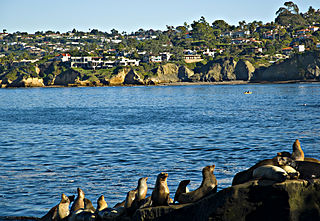
La Jolla is a hilly, seaside neighborhood within the city of San Diego, occupying 7 miles (11 km) of curving coastline along the Pacific Ocean. The population reported in the 2010 census was 46,781. The climate is mild, with an average daily temperature of 70.5 °F (21.4 °C).
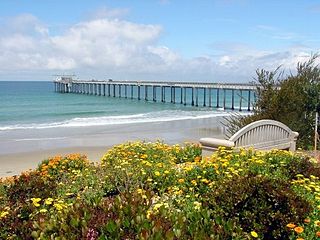
The Scripps Institution of Oceanography (SIO) is the center for oceanography and Earth science based at the University of California, San Diego. Its main campus is located in La Jolla, with additional facilities in Point Loma.

The Bishop's School is an independent college preparatory Episcopal day school located in La Jolla, California. Bishop's is known for its reputation in academics, arts, and athletics as well as its sizable endowment. The school offers courses for students in the sixth through twelfth grades and has an 8:1 student-teacher ratio.
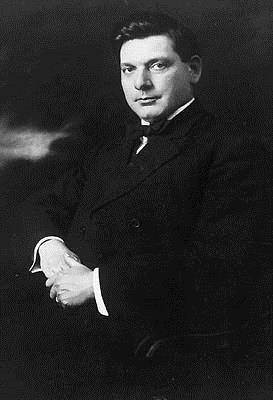
Irving John Gill, was an American architect, known professionally as Irving J. Gill. He did most of his work in Southern California, especially in San Diego and Los Angeles. He is considered a pioneer of the modern movement in architecture. Twelve of his buildings throughout Southern California are listed on the National Register of Historic Places, and many others are designated as historic by local governments.

Edward Willis Scripps, was an American newspaper publisher. He and his sister Ellen Browning Scripps founded the The E. W. Scripps Company, today a diversified media conglomerate, as well as the United Press news service. The E. W. Scripps School of Journalism at Ohio University is named for him.

Ellen Browning Scripps was an American journalist and philanthropist who was the founding donor of several major institutions in Southern California. She and her half-brother E.W. Scripps created the E.W. Scripps Company, America's largest chain of newspapers, linking Midwestern industrial cities with booming towns in the West. By the 1920s, Ellen Browning Scripps was worth an estimated $30 million, most of which she gave away.

William Emerson Ritter was an American biologist.

The George H. Scripps Laboratory, known as the Old Scripps Building, is a historic research facility on the campus of the University of California, San Diego in La Jolla, California. Built in 1909-10, it is the oldest oceanographic research building in continuous use in the United States and the historic center of the Scripps Institution of Oceanography. It is also architecturally significant as a work of Modernist architect Irving J. Gill and for its early use of reinforced concrete. It was declared a National Historic Landmark in 1982. It now houses Scripps administrative offices.
Scripps Health is a nonprofit health care system based in San Diego, California. The system includes five hospitals and 19 outpatient facilities, and treats a half-million patients annually through 2,600 affiliated physicians. The system also includes clinical research and medical education programs.
The La Jolla Historical Society is a private 501(c)(3) nonprofit organization in the La Jolla community within San Diego, California. According to its mission statement, it "celebrates the history and culture of this region along the water's edge through interdisciplinary programs, exhibitions, and research that challenge expectations. It balances contemporary and historic perspectives to create understanding and connection."

San Diego-Scripps Coastal Marine Conservation Area (SMCA) and Matlahuayl State Marine Reserve (SMR) are adjoining marine protected areas that extend offshore from La Jolla in San Diego County on California's south coast. The two marine protected areas cover 2.51 square miles (6.5 km2).

The La Jolla Recreational Center is a historic recreation center in the La Jolla neighborhood of San Diego, California. It was commissioned by philanthropist Ellen Browning Scripps on property adjacent to her home, and designed by San Diego architect Irving Gill. The center was completed in 1915; Scripps donated it to the City of San Diego the same year. On September 7, 1973, it was designated as San Diego Historic Landmark #86.

Anita V. Figueredo was an American surgeon and philanthropist, the first woman medical doctor from Costa Rica and the first woman surgeon to practice in San Diego, California. She was posthumously inducted into the San Diego Women's Hall of Fame in 2015.
Alfred R. Mitchell (1888-1972) was an American landscape painter. He was an early California Impressionist painter. Educated at the Pennsylvania Academy of Fine Arts, he was the president of the San Diego Art Guild and the La Jolla Art Association. He became known as the "Dean of San Diego County artists".
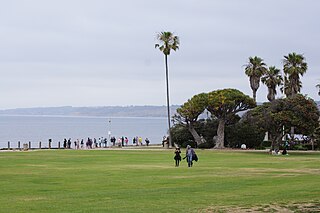
Ellen Browning Scripps Memorial Park, often referred to as Scripps Park, is an urban park located in La Jolla within the city of San Diego, California. The 5.6 acres (2.3 ha) park, part of the unceded ancient homeland and traditional territory of the Kumeyaay Nation, is sited on a sandstone bluff overlooking the Pacific Ocean. It is an open-space, landscaped environment heavily used by residents and visitors from all over the world.

The Red Roost and The Red Rest, built in 1894, are historic beach cottages overlooking La Jolla Cove in La Jolla, San Diego, California. At one time, they were outstanding examples of the first-generation California bungalow. Their placement on the National Register of Historic Places in 1976 has not prevented serious deterioration due to neglect.

The Green Dragon Colony was a group of unique rental cottages that attracted musicians and artists to the seaside community of La Jolla, San Diego, California, between 1895 and 1912. Established by German immigrant Anna Held Heinrich, the colony became a well-known tourist destination in Southern California.
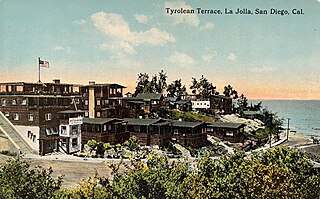
The Tyrolean Terrace Colony (1911–1912) was an Arts & Crafts-style hotel bungalow court in La Jolla, San Diego, California, adjacent to the former Green Dragon Colony. It catered to early automobile traffic along Coast Blvd., a scenic drive that led to La Jolla Park and other sites along the shore.

Coast Walk Trail is a pedestrian trail along the bluffs above sea caves in La Jolla, San Diego, California.


















